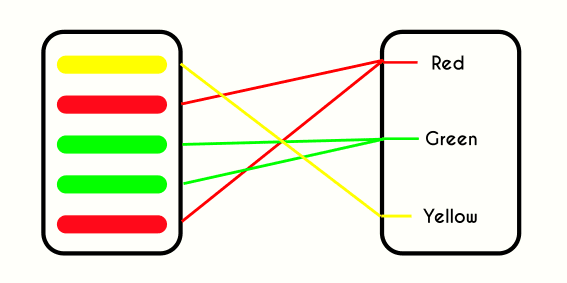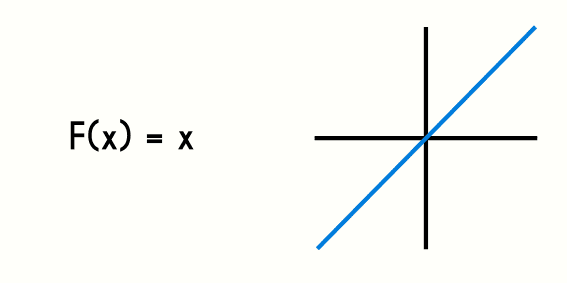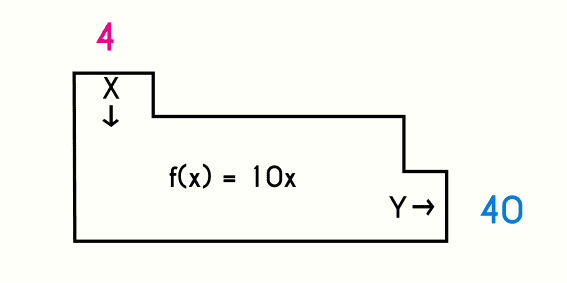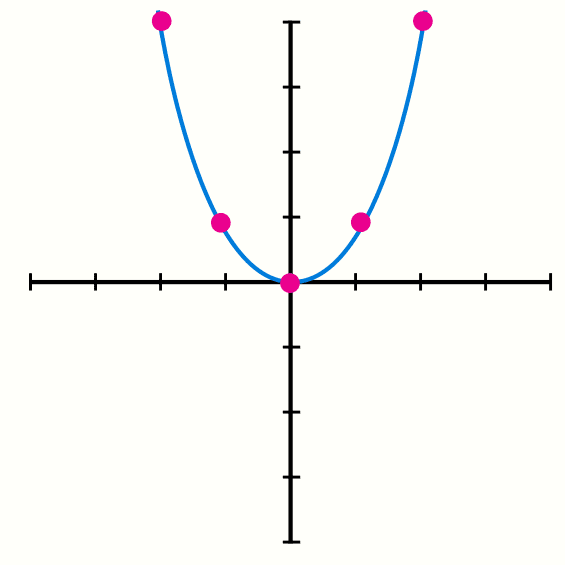Mathematical functions, Definition, Graphic and domain and range
En este artículo Definition of functions, with graphics, examples and domain and range.
Definition of function
Is called a function to a relation between an “A” set and a “B” set where each element of the A set can only take one element of the B set. Although the A set can only take one element of B, an element of B can be related with more than one element of A. This may seem a little complicated, the purpose of the functions is find the relation between 2 data sets, like the distance a human advances and the time, or any other type of relation between two variables.
To understand this a bit better we are going take the following example.

Explanation of the image.
As we can observe in the previous image, the elements that compose the right set are the names of the colors, while the set on the left are the colors, as we can see the names of the colors are related with the colors in the other set, because there is more than one square for each color, but the left set (the colors) can only take one name of the right set, because the blue can not be pink at the same time, so it accomplishes the concept that “The B set can only take one value of the A set” where A are the names of the colors and B are the colors.
Mathematical functions.
The previous example was only to clarify the basic concept of a function, but in reality a function looks like this: f(x) = 4x + 1, a function is only an equation with one variable. Normally the variable is represented by the letter “x” but you can use any letter, and in the left side of the function there is “f(x)” which means “f of x”, but this is like saying “y”: “f(x) = y”.

Evaluate a function
A mathematical function is composed by a dependent and an independent variable, to explain this we are going to make an example.
We are going to take the function f(x) = 2x, to see how this function is going we have to evaluate the function in different values of x, this is done by changing the value of “x” by numeric values.
For example: when “x” takes the value of 0.
- Function to evaluate: f(x) = 2x
- f(0) = 2(0)
- f(0) = 0
As we can see the “x” changes in both sides of the function by the value of x (in this case is 0) and then the equation is solved, and the result was 0, and this is the way we are going to evaluate a function, for example, to evaluate f(x) = 2x in 1, 2 and 3, we are going to make the same process.
- When x = 1
- f(1) = 2(1)
- f(1) = 2
- When x = 2
- f(2) = 2(2)
- f(2) = 4
- When x = 3
- f(3) = 2(3)
- f(3) = 6
- When x = 4
- f(4) = 2(4)
- f(4) = 8
As we can see in the previous example, the independent variable will be “x” and the dependent variable will be “f(x) or y” these are defined like this because depending on the value of “x” the value of f(x) o “y” will change.
Another way to see a function is by imagining it like a system, where we can introduce any number we want, and this system throws an answer, just like the following illustration.

Domain and range of a function.
The domain and range of a function defines how far does the function reaches in terms of numbers, the domain are every number that “x” can take and the range of the function (sometimes called image of the function) to every value of “y” that is a part of the function.
Reminder: the real numbers are the set of numbers that contains the positive, negative and decimal numbers.
What is the domain of a function
Domain of a function when we talk about a valid number of “x”, we mean that the result when we evaluate the function in “x” is a valid number that can be represented in the Real numbers, for example in the following function; f(x) = 2x, no matter which value the “x” variable takes, either very high or very low, the answer will be always a real number, in cases like the previous example, the domain is defined as the Reals.
The domain of the previous function could be written in intervals the following way: ]-∞, +∞].
The domain of a mathematical function stops being the reals when there is a value of “x” that is not accepted in the function, for example, in the function f(x)=1/x, both x=1 and x=-1 have an accepted answer, but when the x takes the value of 0, then the equation cannot be solved, because we would be dividing by 0 and we cannot do that (until now), so the domain of this function would not be all the reals because 0 is part of the reals but not a part of the domain of function.
What is the range of a function
Range of a function: the range of a function is formed by every result of f(x) when we evaluate the function, the range of the function will depend a lot on the type of function we have.
In the function f(x) = 4x, the range are the reals, because the more the “x” grows, higher will be the value of the range, and vice versa, the lower the number of “x” is, the lower the range will be till infinite in both sides.
A function where we can appreciate that the range of a function does not point infinite is in the sine function, f(x) = sin(x), here the range goes from -1 to 1, so the amplitude of the range is only of 2, we can check this by evaluating the function in multiple values of “x” and the answer will always be a number between -1 and 1.
The domain and range of a function depends on the type of function.
Defining the domain and range of a function by just evaluating the function is basically impossible, this is why there are many different ways to define the domain and range of a function, in some cases we just need to see the function to know the domain and range, but in most of the cases, we have to make a process to obtain the domain and range.
Graphic a mathematical function
A big part of the functions subject are the graphics, because depending on the type of function the graphic will change. To graphic a function, the most common way to do it is evaluating some values of “x” and take the results of “y”, this way we would have the coordinates where the function passes, and then we just have to place the coordinates in the Cartesian plane and draw a line to graphic the function.
Just as with the domain and range, there are some process that allows us to graphic the function of a more direct way just by using the equation of the function.
To demonstrate how to graphic a function we are going to make the following example: graphic the function: f(x) = x2.
The first thing we have to do is to make a table and in the left column we are going to put the values of “x” in which we are going to evaluate the function, in the central column the equation with each value of “x” and in the right column we are going to write the results, and with this we already would have the coordinates where the function passes.
| x | f(x) = x2 | y |
|---|---|---|
| -2 | f(-2) = -22 | 4 |
| -1 | f(-1) = -12 | 1 |
| 0 | f(0) = 02 | 0 |
| 1 | f(1) = 12 | 1 |
| 2 | f(2) = 22 | 4 |
Now we put the coordinates in the Cartesian plane and we draw a line that connects every point.

As we can see, in this case like the function is a squared function, the form of the graphic has a parabolic shape.
One of the characteristics of the functions is that if we draw a vertical line, it can only cut with the function once, otherwise, we would be talking about a relation, not a function, this is because, as we said, the domain can only take one value of the range.

Types of functions
As we explained, there are many types of functions, a type of function is defined by the form of its equation, for example, a linear function is the one that has a first grade equation, this means that the variable “x” is raised to the power of 1, as it could be f(x) = 2x, a quadratic function is when the variable is raised to the power of 2, like f(x) = 2x2, and like this, depending on the equation of the function.
There is a great number of functions, where each function has a different way to find the graphic, domain and range, some of them are pretty simple to solve, and there are some that are more complex, but the important thing here is to have clear the basic concept of a function, how to evaluate a function and analyze the behavior of a function.
Now we are going to present a series of links to other articles, like the definition of each type of function, how to graphic each type of function and how to define the domain and range of each type of function.